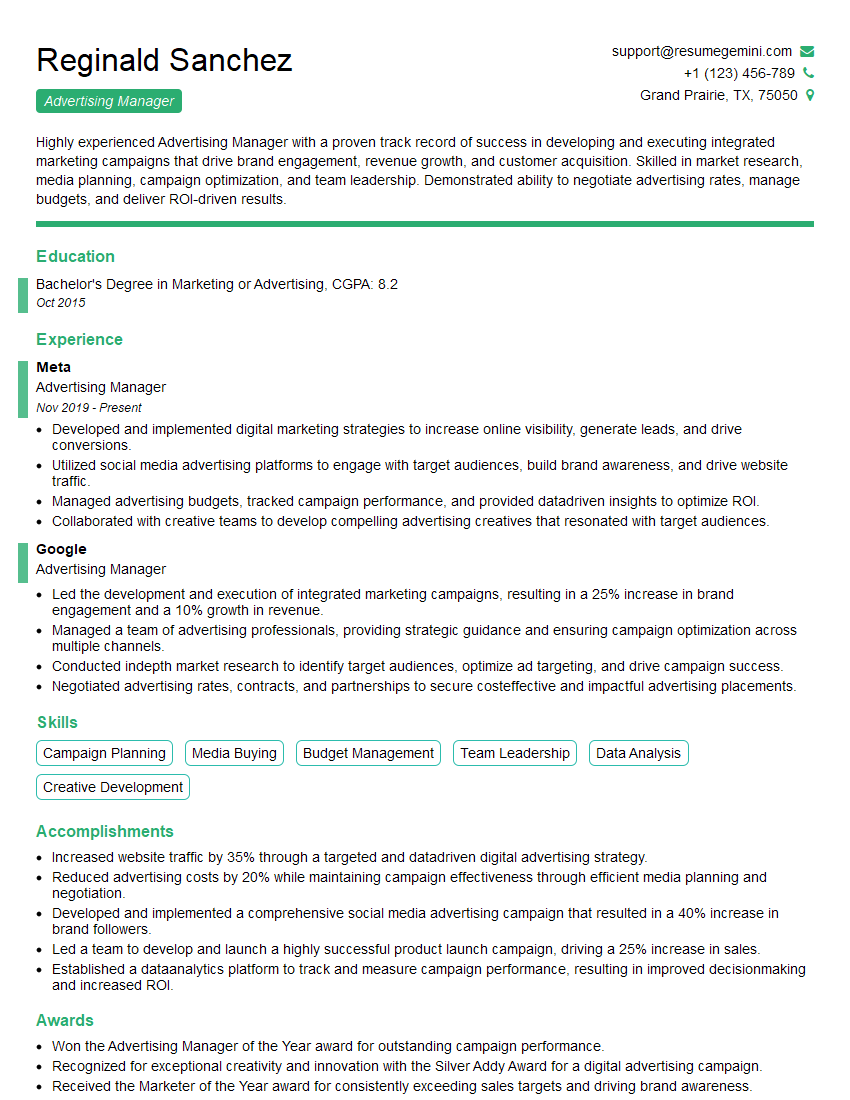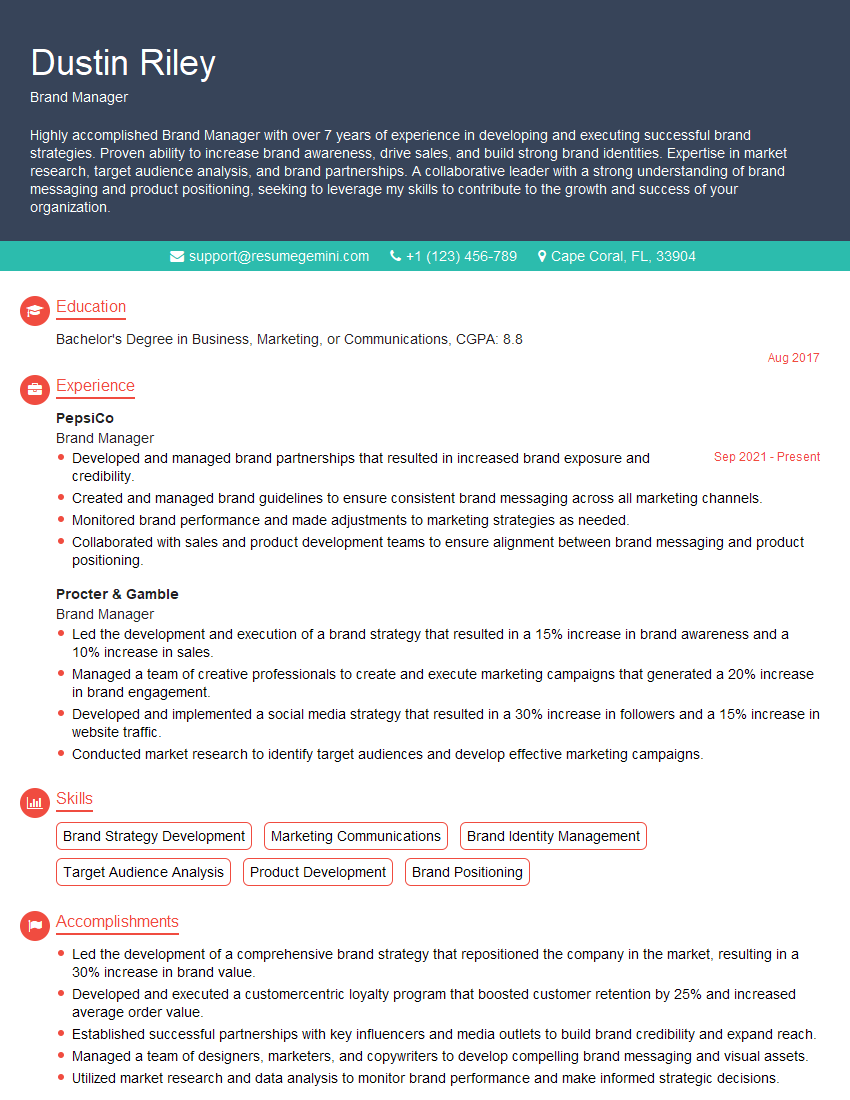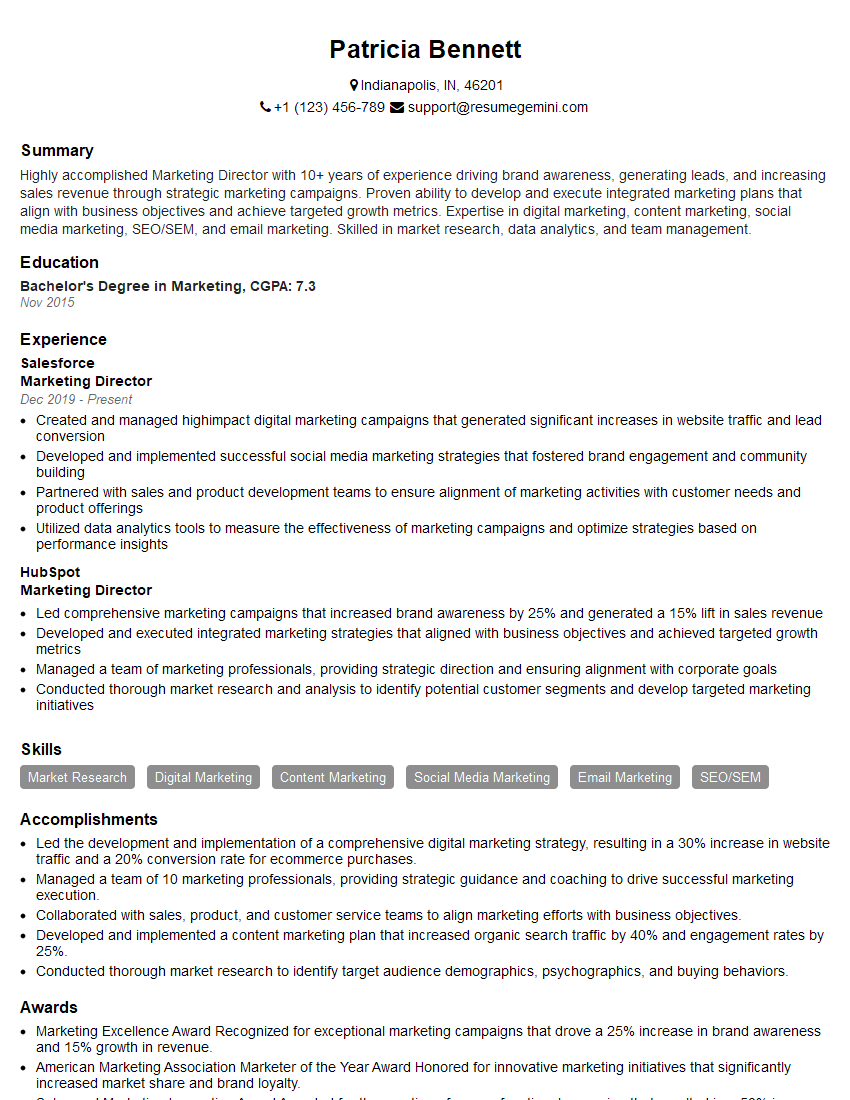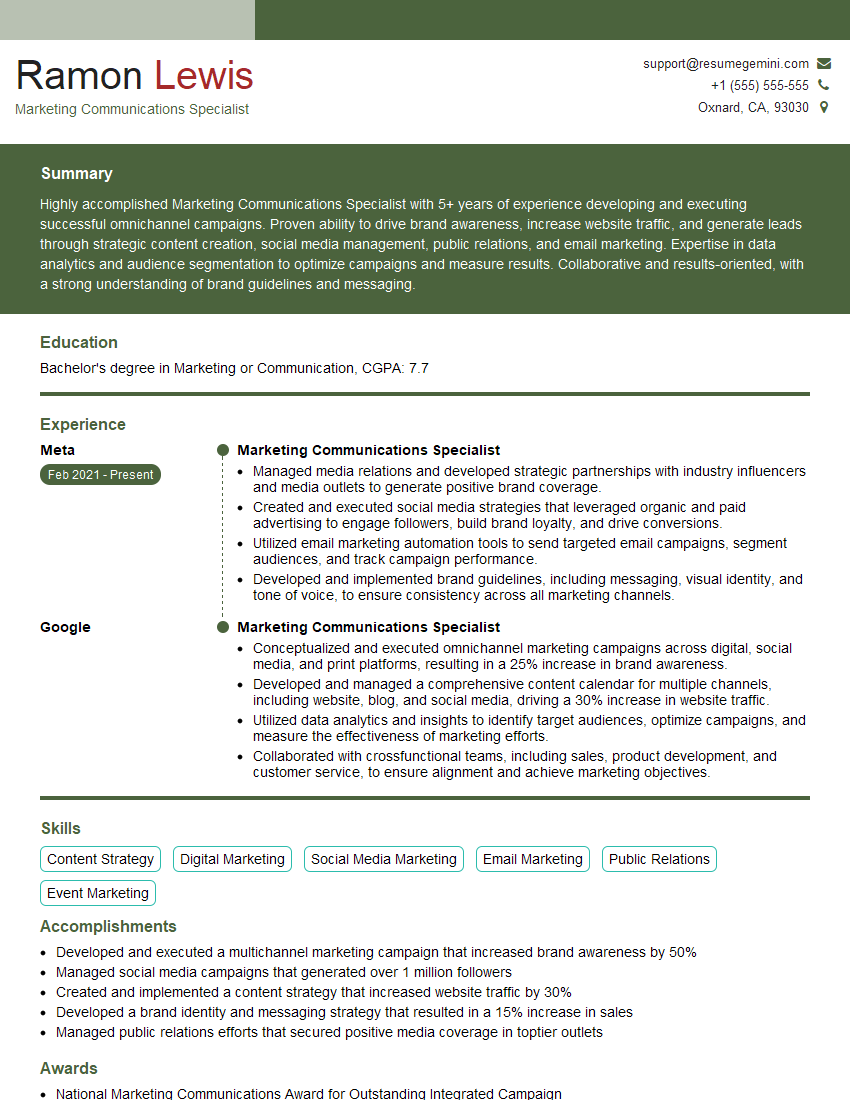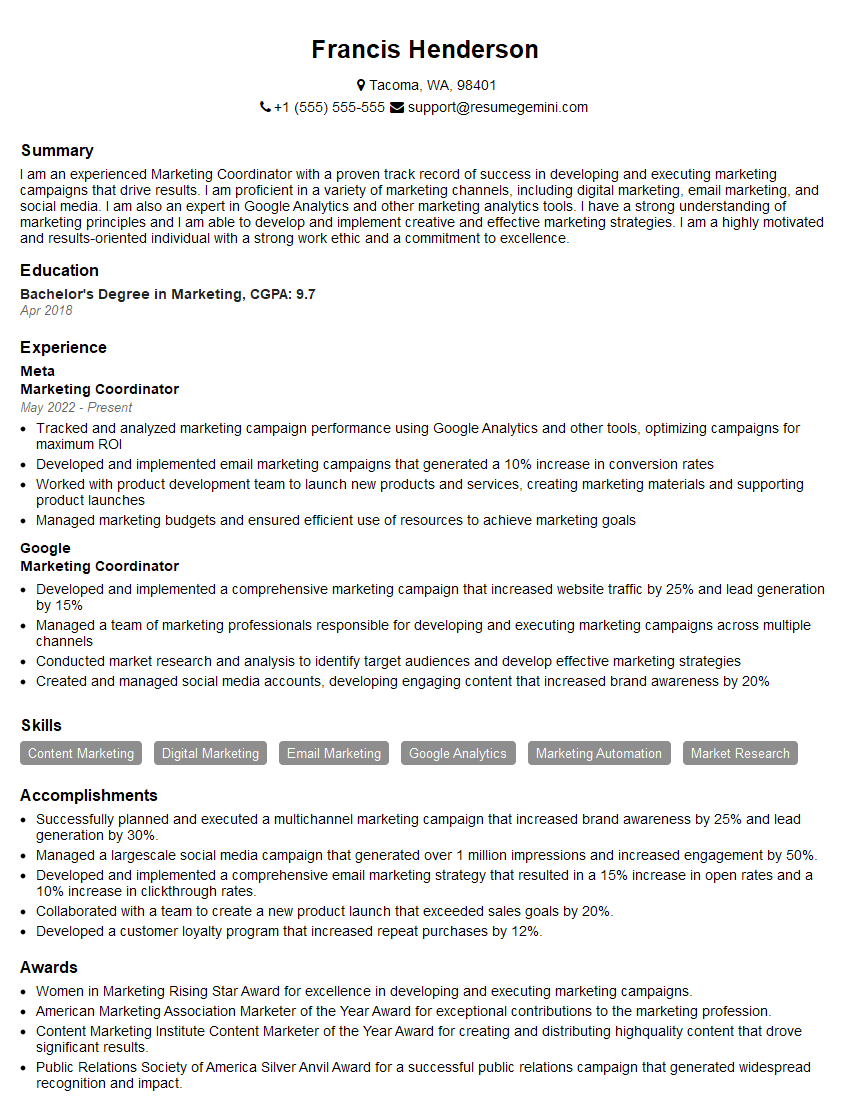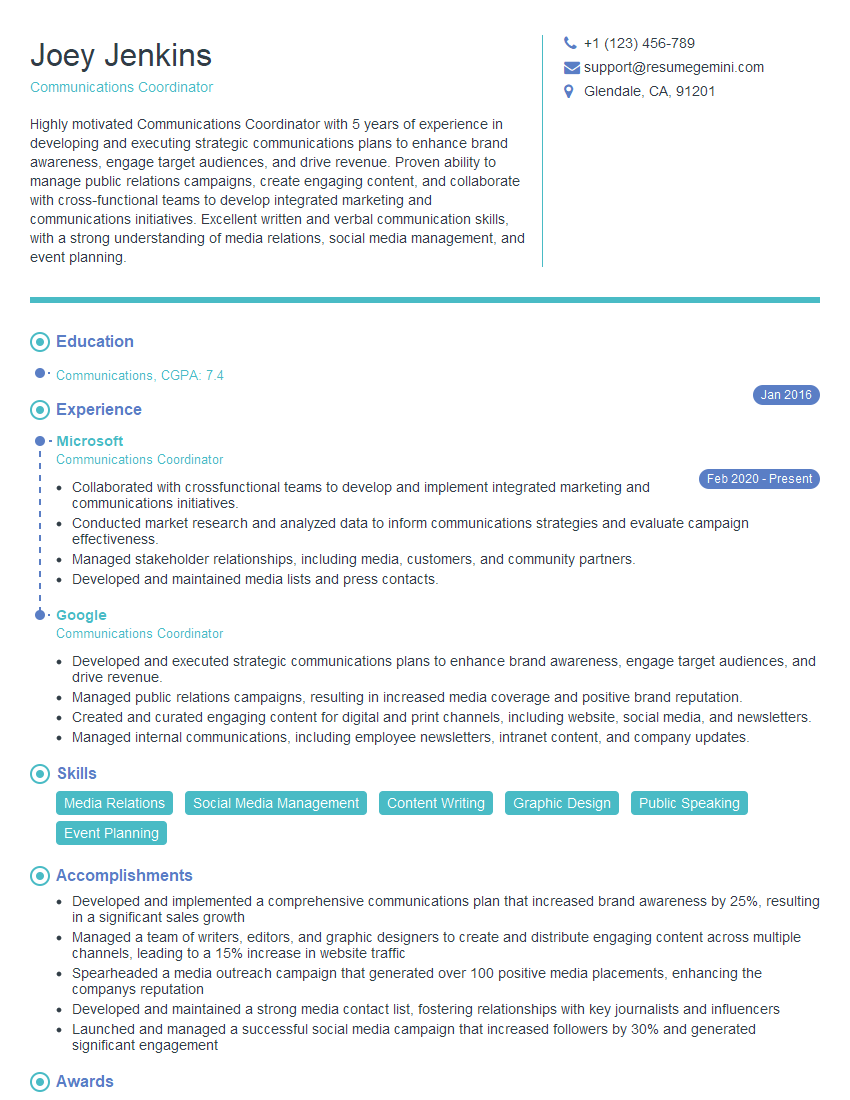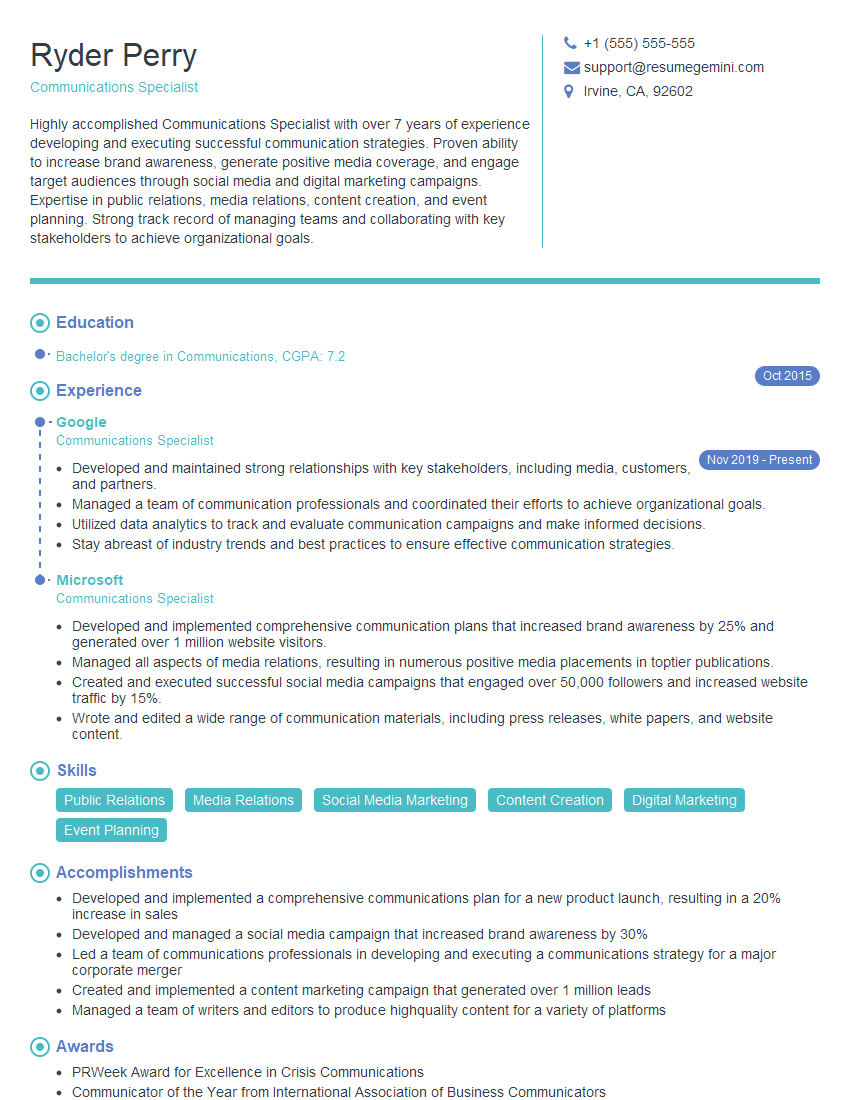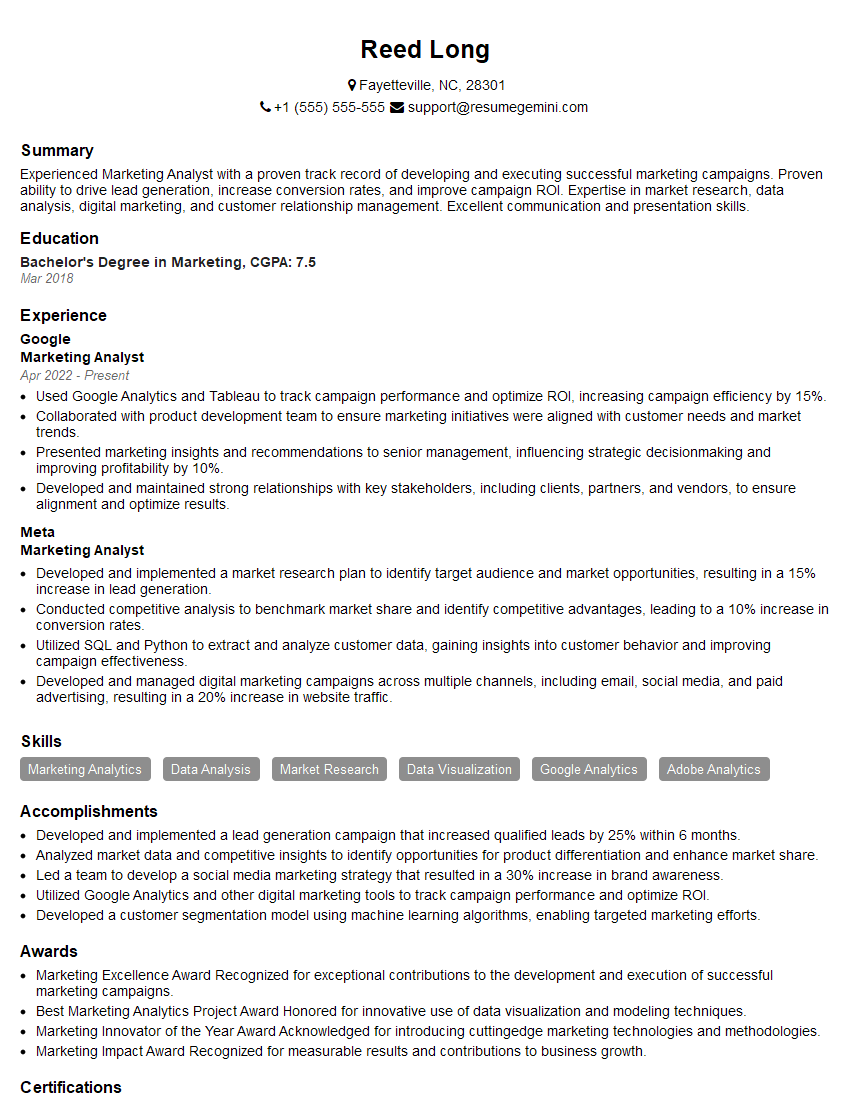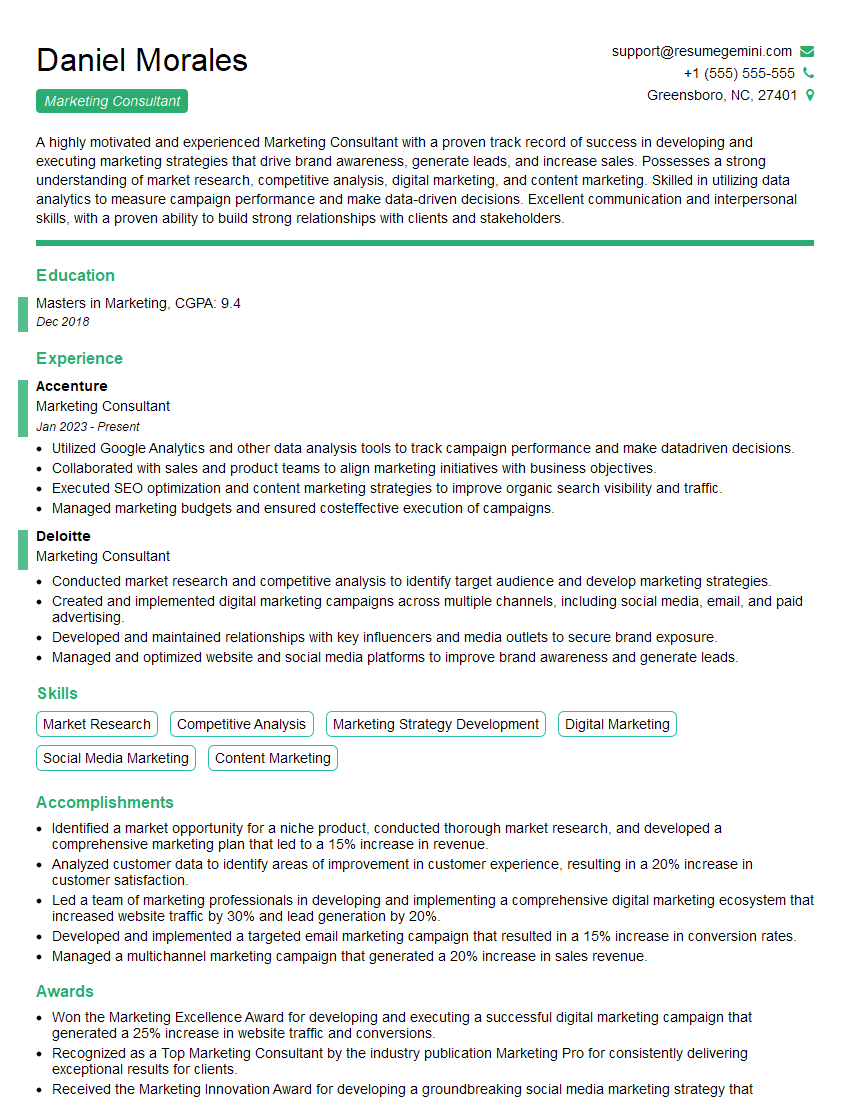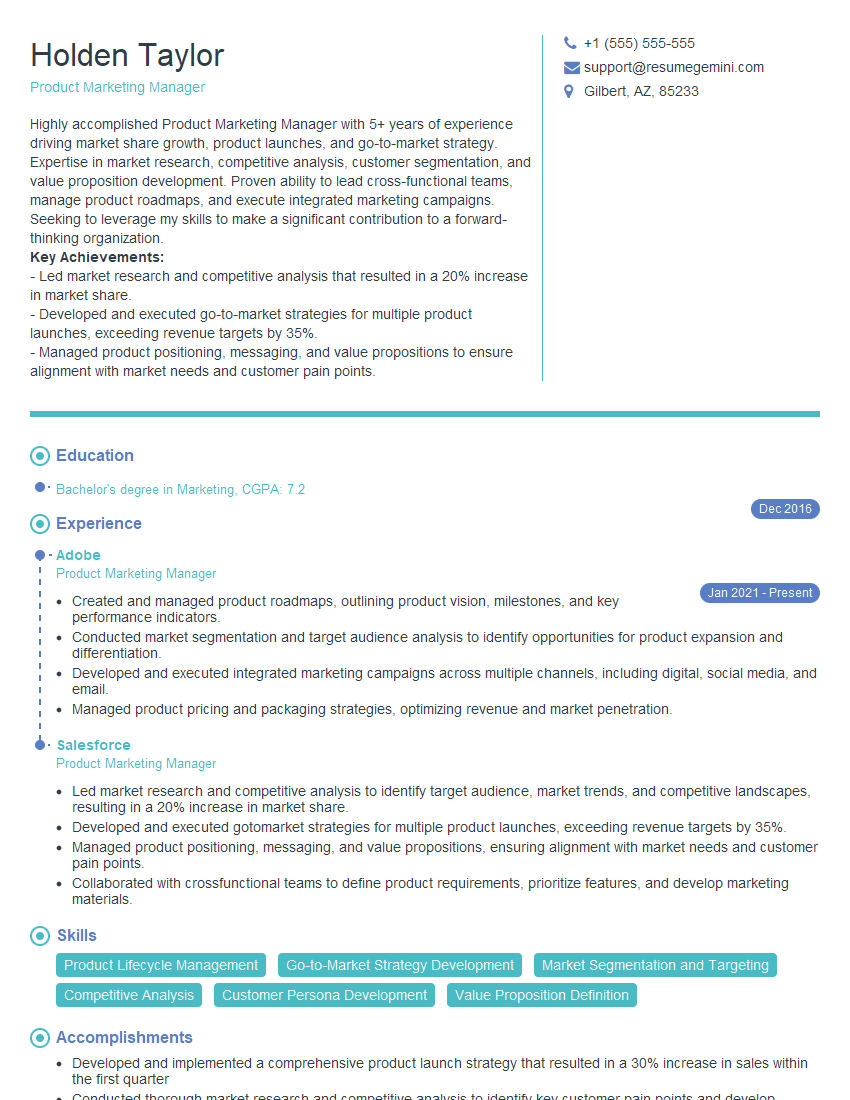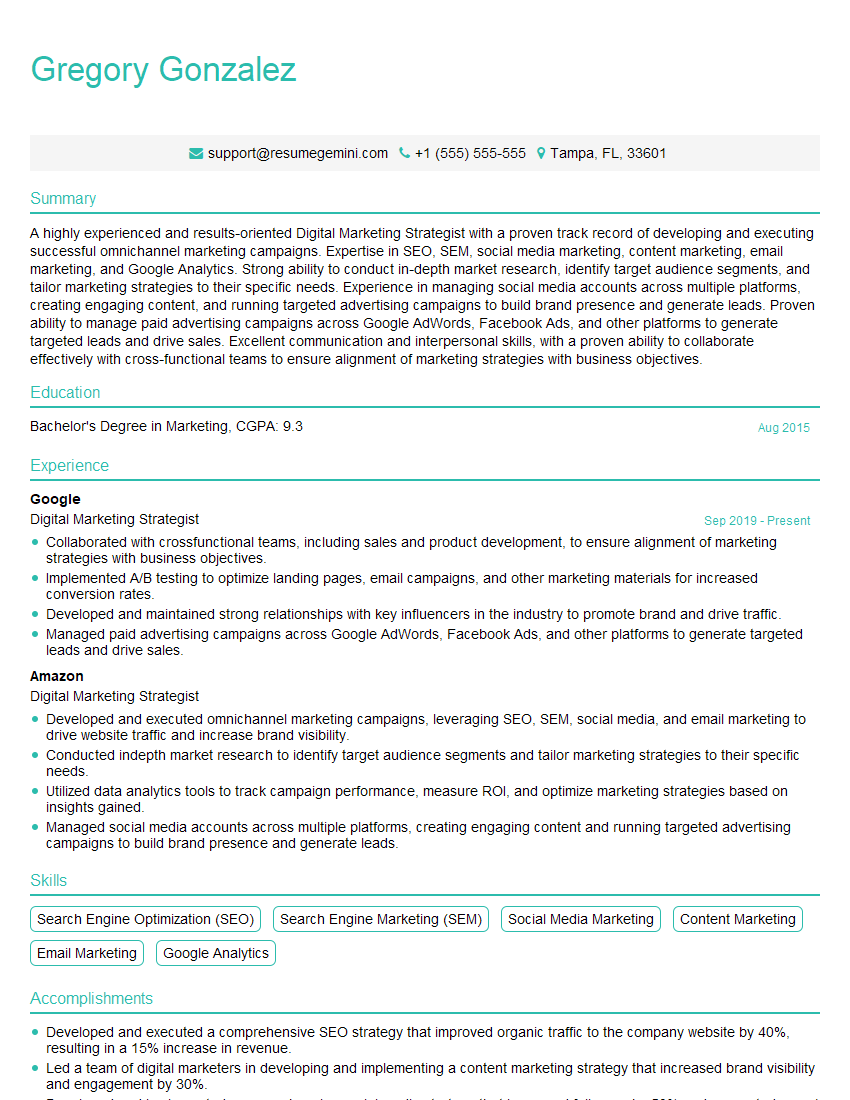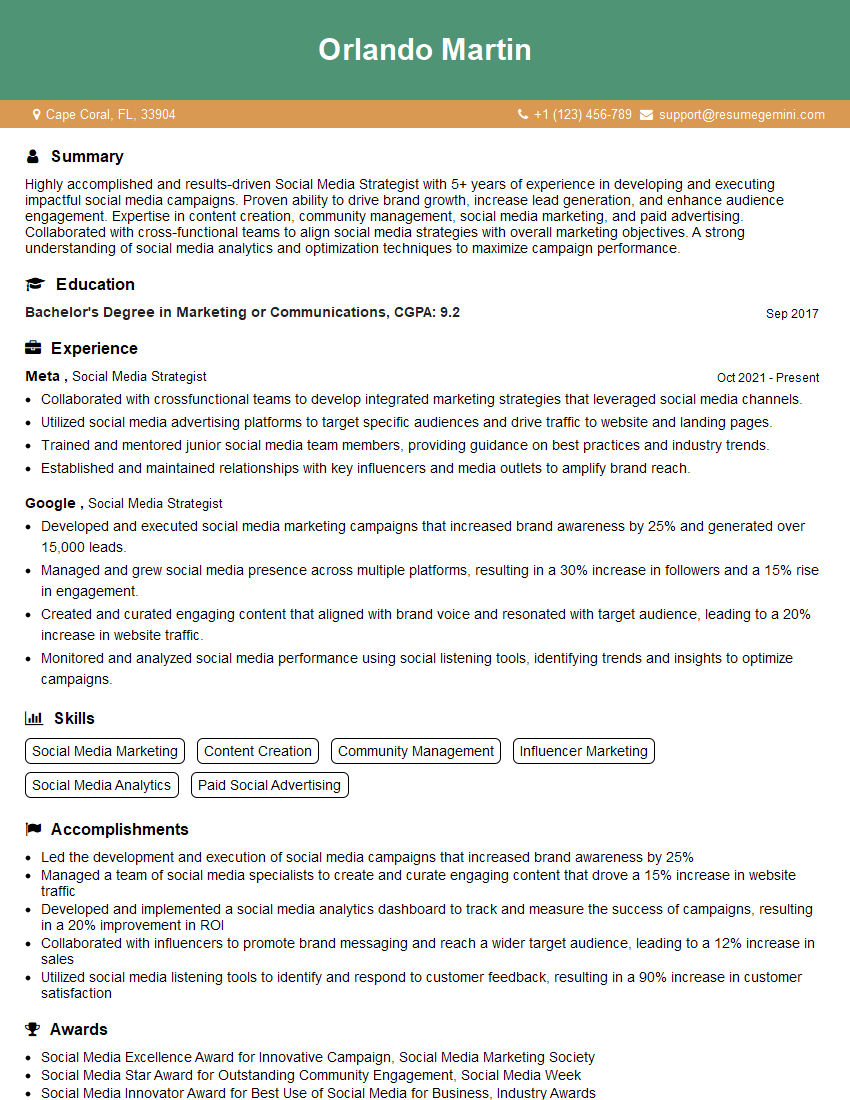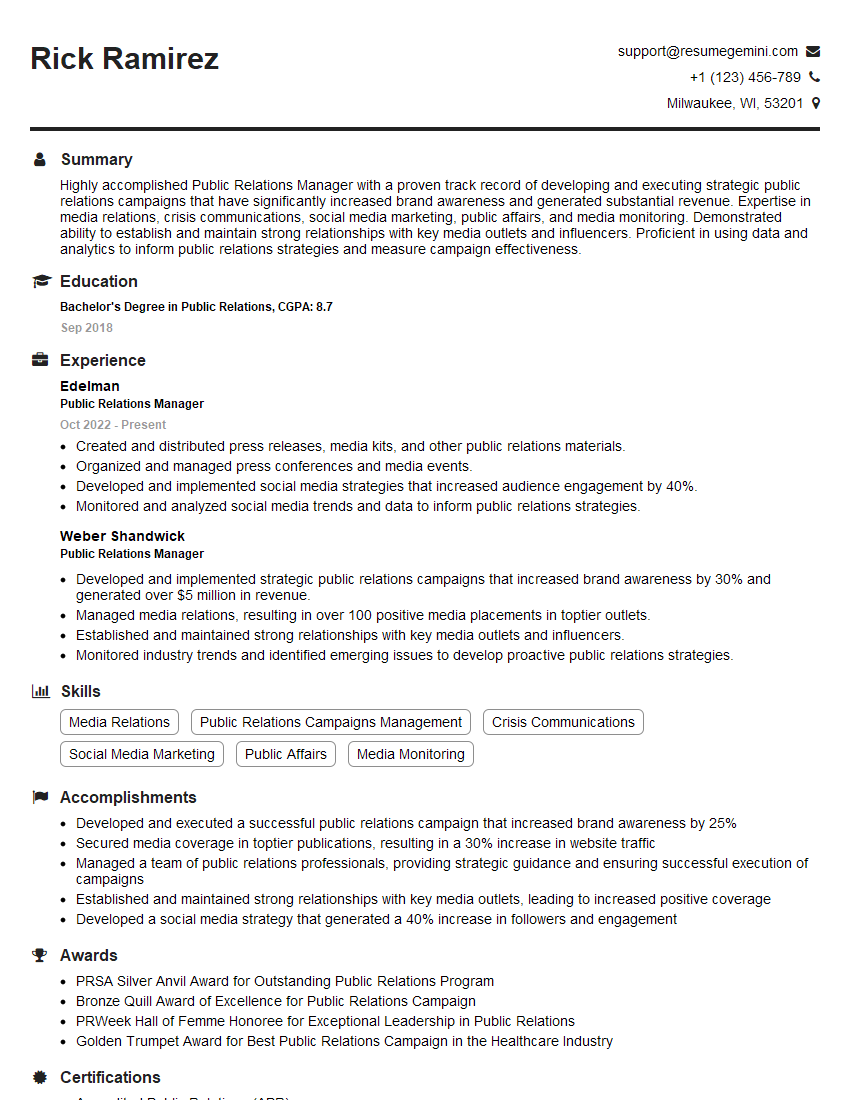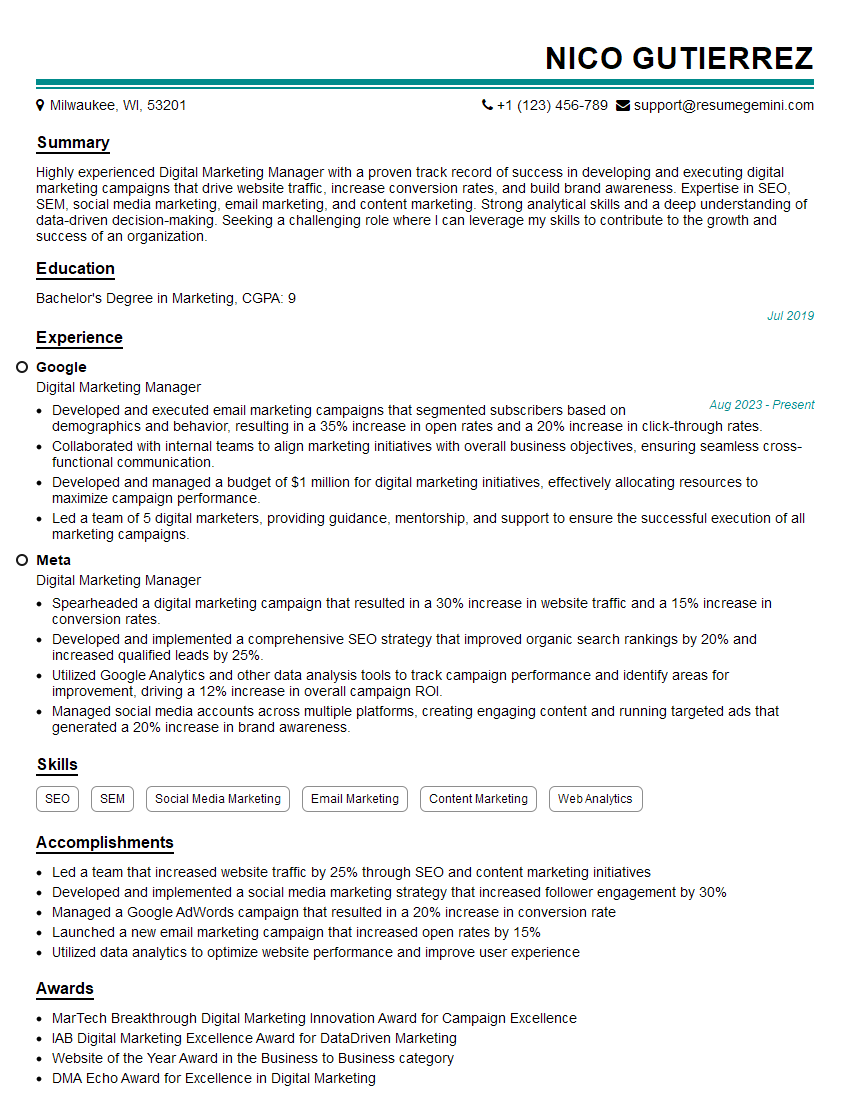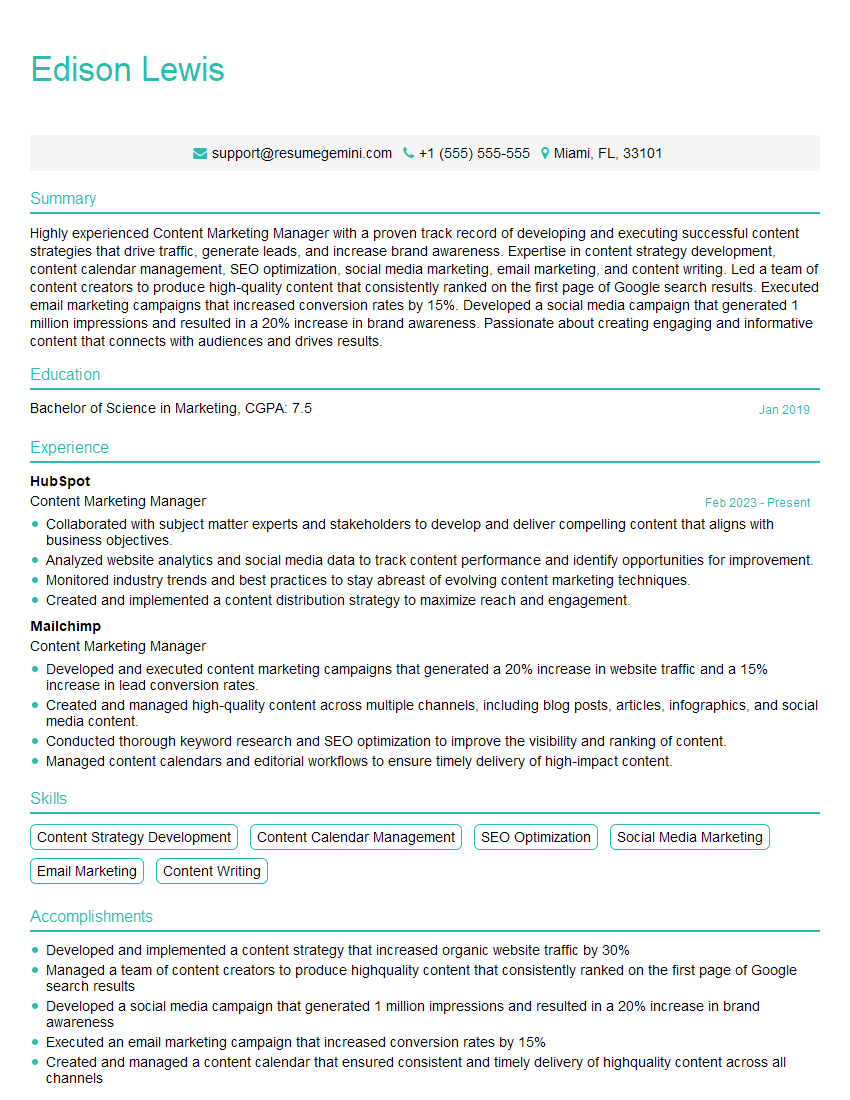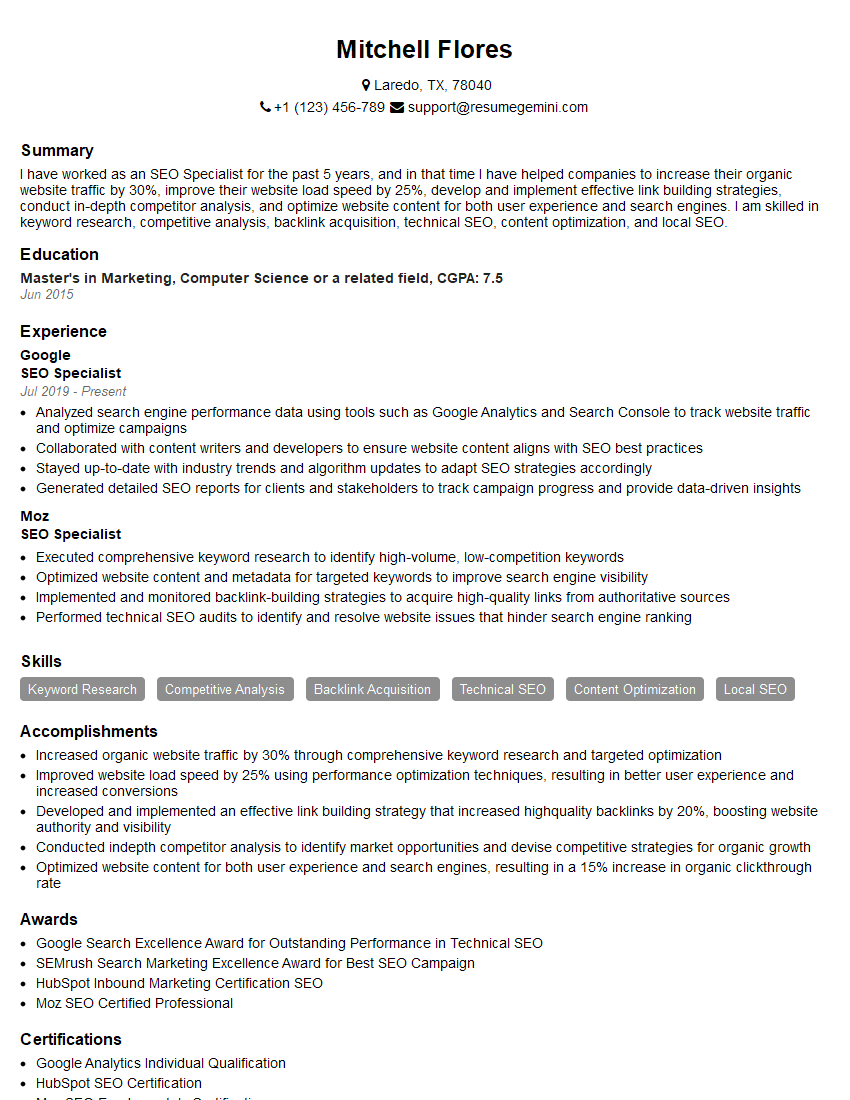The thought of an interview can be nerve-wracking, but the right preparation can make all the difference. Explore this comprehensive guide to Marketing and Communications Strategies interview questions and gain the confidence you need to showcase your abilities and secure the role.
Questions Asked in Marketing and Communications Strategies Interview
Q 1. Explain your understanding of the marketing mix (4Ps or 7Ps).
The marketing mix, often represented by the 4Ps (Product, Price, Place, Promotion) or the 7Ps (adding People, Process, and Physical Evidence), is a foundational framework for developing a comprehensive marketing strategy. It helps businesses understand and manage the key elements that influence their customers’ purchasing decisions.
- Product: This encompasses the goods or services offered, their features, benefits, branding, and packaging. For example, a company might differentiate its product through superior quality, unique design, or innovative functionality.
- Price: This refers to the pricing strategy employed, considering factors like cost of production, competitor pricing, perceived value, and target market. Strategies could include premium pricing, competitive pricing, or penetration pricing.
- Place: This focuses on the distribution channels used to make the product available to customers, such as online stores, physical retail locations, wholesalers, or direct sales. A strong place strategy ensures the product is accessible to the target audience.
- Promotion: This involves communicating the value proposition to the target market using various channels like advertising, public relations, sales promotions, and content marketing. A well-defined promotional mix can significantly impact brand awareness and sales.
- People: (7Ps) The quality of interaction between customers and employees, impacting the customer experience. A friendly and knowledgeable sales team can greatly enhance brand perception.
- Process: (7Ps) The systems and procedures involved in delivering the product or service, crucial for efficiency and a smooth customer journey. Streamlined processes lead to higher customer satisfaction.
- Physical Evidence: (7Ps) The tangible aspects of the brand, such as the store design, website, packaging, or even business cards. A visually appealing and consistent brand image reinforces trust and professionalism.
Consider a coffee shop: Their product is coffee and pastries; price is determined by cost and market competition; place is the physical shop and potentially delivery services; promotion might include social media ads and loyalty programs; people are the baristas; process is order taking and coffee preparation; and physical evidence is the café’s ambiance and packaging.
Q 2. Describe your experience with SEO and SEM strategies.
I have extensive experience in both SEO (Search Engine Optimization) and SEM (Search Engine Marketing) strategies. SEO focuses on organic search results, improving website visibility through techniques like keyword research, on-page optimization (title tags, meta descriptions, content optimization), and off-page optimization (link building, social media promotion). SEM, on the other hand, involves paid advertising on search engines like Google Ads, allowing for targeted reach and immediate visibility.
In a previous role, I successfully implemented an SEO strategy that increased organic traffic by 40% within six months. This involved a thorough keyword analysis, creating high-quality, relevant content, and building high-authority backlinks. Simultaneously, I managed a SEM campaign, optimizing ad copy and targeting to maximize ROI. We used A/B testing to continually improve ad performance, achieving a significant increase in conversion rates.
I understand the interplay between SEO and SEM. For example, a well-optimized website (SEO) can improve the Quality Score of paid ads (SEM), leading to lower costs and better ad positions. A successful digital marketing strategy leverages both strategies for comprehensive reach.
Q 3. How do you measure the success of a marketing campaign?
Measuring the success of a marketing campaign requires a clearly defined set of Key Performance Indicators (KPIs) aligned with the campaign’s objectives. These KPIs should be measurable, trackable, and relevant to the business goals. Common KPIs include:
- Website traffic: Measuring visits, bounce rate, and time on site.
- Lead generation: Number of leads generated, conversion rate, and lead quality.
- Sales: Increase in revenue, number of transactions, and average order value.
- Brand awareness: Social media mentions, website traffic from brand searches, and survey data.
- Customer acquisition cost (CAC): The cost of acquiring a new customer.
- Return on investment (ROI): The return on marketing investment.
For instance, if the objective is to increase brand awareness, KPIs might focus on social media engagement and reach. If the goal is to drive sales, KPIs would center on revenue generated and conversion rates. Regular monitoring and analysis of these KPIs are crucial for campaign optimization and to ensure we’re making data-driven decisions. We use tools like Google Analytics and marketing automation platforms to track these metrics efficiently.
Q 4. What is your approach to developing a marketing strategy for a new product launch?
My approach to developing a marketing strategy for a new product launch is systematic and data-driven. I follow these steps:
- Market Research: Thorough research to understand the target market, competitive landscape, and potential demand for the product.
- Value Proposition Definition: Clearly define the unique selling proposition (USP) – what makes this product stand out.
- Target Audience Segmentation: Identify key demographics and psychographics of the target audience.
- Marketing Mix Development: Design the appropriate product, pricing, place, and promotion strategies based on the target audience and USP. This might involve creating targeted advertising campaigns, PR outreach, influencer marketing, or content marketing strategies.
- Channel Selection: Choosing the optimal channels for reaching the target audience (e.g., social media, email marketing, paid advertising, content marketing).
- Budget Allocation: Developing a realistic budget allocation for different marketing activities.
- Campaign Implementation: Executing the marketing plan and tracking progress.
- Performance Monitoring and Optimization: Regular monitoring of KPIs, analyzing performance, and making necessary adjustments.
For example, when launching a new health supplement, we might target health-conscious individuals via social media ads emphasizing the product’s health benefits. Content marketing would focus on educational blog posts and videos, driving engagement and building trust. Simultaneously, partnerships with relevant influencers could increase brand awareness.
Q 5. Explain your experience with content marketing and content strategy.
Content marketing and content strategy are central to my approach. Content marketing involves creating and distributing valuable, relevant, and consistent content to attract and retain a clearly defined audience — and, ultimately, to drive profitable customer action. A content strategy is the plan outlining what content will be created, how it will be distributed, and how its success will be measured.
My experience includes developing and implementing content strategies across various platforms, including blogs, social media, email newsletters, and videos. I always begin by conducting thorough keyword research to identify relevant topics and search terms. Then, I develop a content calendar, outlining the type, format, and publication schedule of the content. I also work closely with designers and writers to ensure high-quality content creation. For example, I worked on a project where we created a series of educational videos on a complex financial product, resulting in a significant increase in website traffic and lead generation.
Measuring the success of content marketing involves tracking metrics such as website traffic, engagement rates (likes, shares, comments), lead generation from content downloads, and ultimately, sales attributable to the content.
Q 6. How do you manage a marketing budget effectively?
Effective marketing budget management requires a meticulous approach. I start by clearly defining the marketing objectives and aligning the budget with those objectives. This involves prioritizing activities based on their potential return on investment (ROI).
I use a combination of methods to manage a marketing budget. This might involve creating a detailed budget spreadsheet allocating funds to different marketing activities, tracking expenses regularly against the budget, using project management software to track campaign spending, and regularly reviewing the budget to make adjustments based on performance data. I often use the 80/20 rule, focusing 80% of the budget on proven high-performing channels and 20% on experimentation with new channels or strategies. I also look for opportunities to optimize spending by negotiating better rates with vendors or automating tasks to reduce costs.
Regular reporting and analysis are vital for ensuring the budget is being used efficiently. By tracking KPIs and comparing actual spending to the budget, we can identify areas for improvement and optimize resource allocation for better ROI.
Q 7. Describe your experience with social media marketing and platform selection.
Social media marketing plays a crucial role in today’s digital landscape. My experience encompasses strategy development, content creation, community management, and advertising across various platforms, including Facebook, Instagram, Twitter, LinkedIn, and TikTok. Platform selection depends entirely on the target audience and campaign objectives.
For example, a B2B (business-to-business) company might focus on LinkedIn for professional networking and lead generation, while a fashion brand might prioritize Instagram for visual storytelling and engagement with a younger audience. A food company might use TikTok for short, engaging video content. I typically begin by analyzing the demographics and online behavior of the target audience to identify the most suitable platforms.
Beyond platform selection, success in social media marketing relies on creating engaging content, running targeted ad campaigns, and actively interacting with the community. Using analytics tools to monitor engagement, reach, and ROI is key for optimization and maximizing the effectiveness of social media strategies.
Q 8. How do you handle negative feedback or online criticism?
Negative feedback, while initially challenging, presents a valuable opportunity for growth and improvement. My approach involves a three-step process: Listen, Respond, and Adapt.
Listen: I carefully analyze the feedback, identifying recurring themes and underlying concerns. This might involve sentiment analysis of online reviews or meticulously reviewing individual comments. It’s crucial to understand the why behind the negative feedback, not just the what.
Respond: My response depends on the platform and severity. Public criticism often necessitates a public response, acknowledging the concern and offering a solution or explanation. A simple, empathetic response like, “We appreciate you bringing this to our attention. We’re investigating the issue and will get back to you within [timeframe]” can go a long way. Private feedback allows for more direct engagement and personalized solutions.
Adapt: Finally, I use the feedback to inform improvements. This might involve product changes, service adjustments, or refinements to our communication strategies. Tracking the impact of these changes helps demonstrate the value of actively managing negative feedback.
For example, during a product launch, we received negative feedback about the user interface. By analyzing the comments, we identified a usability issue with the navigation. We addressed this in a subsequent software update and publicly announced the improvement, demonstrating our responsiveness and commitment to customer satisfaction.
Q 9. How do you measure ROI for a marketing campaign?
Measuring the Return on Investment (ROI) of a marketing campaign requires a clear understanding of your campaign goals and a robust tracking system. A simple formula, while not encompassing all aspects, is (Revenue Generated - Campaign Cost) / Campaign Cost. However, a more comprehensive approach considers various key performance indicators (KPIs).
Key KPIs for ROI Calculation:
- Website Traffic: Track visits, bounce rates, and time spent on site to assess campaign effectiveness in driving engagement.
- Lead Generation: Monitor the number of leads generated and their quality (e.g., using a lead scoring system).
- Conversions: Measure the number of customers who completed desired actions (e.g., purchases, sign-ups). This is often the most critical metric.
- Brand Awareness: Assess changes in brand mentions, social media engagement, and search rankings (though often harder to quantify directly).
- Customer Lifetime Value (CLTV): Project the long-term revenue generated from acquired customers.
Example: A social media campaign cost $5000 and generated 100 new customers with an average purchase value of $100. The revenue generated is $10,000. The ROI would be ($10,000 - $5,000) / $5,000 = 1 or 100%. However, a deeper dive into CLTV and other KPIs provides a more holistic understanding of the campaign’s long-term value.
Q 10. What are your preferred marketing analytics tools?
My preferred marketing analytics tools depend on the specific campaign and client needs, but I frequently utilize a combination of platforms for a comprehensive view. Some of my go-to tools include:
- Google Analytics: For detailed website traffic analysis, user behavior tracking, and conversion monitoring. It’s indispensable for understanding website performance.
- Google Ads: To track the performance of paid advertising campaigns, optimize bidding strategies, and measure ROI.
- Social Media Analytics (e.g., Facebook Insights, Twitter Analytics): To monitor engagement, reach, and sentiment on various social media platforms.
- Marketing Automation Platforms (e.g., HubSpot, Marketo): For tracking email marketing performance, lead nurturing, and campaign automation.
- CRM systems (e.g., Salesforce, Zoho CRM): For managing customer relationships and tracking customer journeys across multiple touchpoints.
I also value tools offering data visualization and reporting capabilities to easily communicate findings and insights to stakeholders.
Q 11. Describe your experience in crisis communications.
Crisis communications require a swift, decisive, and transparent response. My experience involves establishing a clear communication strategy, ensuring consistent messaging, and proactively addressing concerns.
My approach to crisis communication involves:
- Rapid Assessment: Quickly assess the situation, understanding its scope and potential impact.
- Establish a Central Communication Hub: Designate a team to manage communication across all channels.
- Develop a Consistent Message: Craft a clear, concise, and empathetic message addressing the crisis directly.
- Proactive Communication: Disseminate information proactively across all relevant platforms to control the narrative.
- Monitor Social Media and Online Conversations: Track public sentiment and respond to concerns effectively.
- Transparency and Honesty: Acknowledge mistakes and offer sincere apologies when appropriate.
- Post-Crisis Review: Conduct a thorough review to identify areas for improvement in future crisis management.
In a past role, a product recall necessitated immediate action. We established a dedicated crisis communication team, issued a press release, updated our website, and engaged directly with customers via social media and email. Open communication and swift action helped mitigate damage and retain customer trust.
Q 12. How do you adapt marketing strategies to different target audiences?
Adapting marketing strategies to different target audiences is crucial for success. It involves understanding each audience’s unique characteristics, needs, and preferences. This is achieved through thorough market research and audience segmentation.
Key Considerations for Adapting Strategies:
- Demographics: Age, gender, location, income, education, and family status significantly influence preferences.
- Psychographics: Values, lifestyle, interests, and attitudes shape consumer behavior.
- Behavioral Segmentation: Past purchase history, website activity, and engagement with marketing materials offer insights into preferences.
- Messaging: Tailor the language, tone, and imagery to resonate with each audience. A younger audience might respond better to short, video-based content, while an older audience might prefer longer-form articles.
- Channels: Choose the most effective communication channels to reach each target audience. For instance, a younger audience might be more active on TikTok, while an older audience might be more engaged with email marketing.
For instance, a skincare company might tailor its messaging for teenagers emphasizing acne solutions, while targeting older customers with anti-aging products and sophisticated marketing materials.
Q 13. What is your experience with A/B testing?
A/B testing, also known as split testing, is a crucial method for optimizing marketing campaigns. It involves comparing two versions (A and B) of a marketing element—such as a headline, image, or call-to-action—to determine which performs better. This data-driven approach enables continuous improvement.
My Experience with A/B Testing:
- Landing Page Optimization: I’ve extensively used A/B testing to optimize landing page elements like headlines, calls-to-action, and form designs to improve conversion rates.
- Email Marketing: A/B testing subject lines, email content, and send times helps optimize email open and click-through rates.
- Ad Creative: Testing different ad visuals, copy, and targeting options helps improve ad performance and ROI.
Example: In a recent campaign, we A/B tested two different headlines for an email. Headline A had a higher open rate, indicating that it resonated better with the target audience.
The key to effective A/B testing is to only test one variable at a time, to ensure accurate results and avoid confounding variables. Furthermore, sufficient sample size is critical to ensure statistical significance.
Q 14. How familiar are you with marketing automation tools?
I am highly familiar with marketing automation tools and have extensive experience using them to streamline marketing processes and improve efficiency. These tools are instrumental in automating repetitive tasks, personalizing customer interactions, and tracking campaign performance.
My experience includes using platforms such as:
- HubSpot: A comprehensive platform offering email marketing, CRM, landing page creation, and analytics.
- Marketo: A robust platform for enterprise-level marketing automation, ideal for complex campaigns and large datasets.
- Mailchimp: A user-friendly platform for email marketing automation, suitable for smaller businesses.
These platforms allow for automated email sequences, lead nurturing workflows, and personalized content delivery based on customer behavior. This results in improved lead generation, increased customer engagement, and better ROI. For example, I’ve implemented automated email workflows to nurture leads through the sales funnel, ultimately increasing conversion rates.
Q 15. Explain your understanding of branding and brand management.
Branding is the overall perception of a company, product, or service in the minds of consumers. It’s more than just a logo; it encompasses the entire customer experience, encompassing values, mission, visual identity, messaging, and customer interactions. Brand management is the strategic process of building, protecting, and enhancing a brand’s value and reputation over time. It involves consistent messaging, careful monitoring of brand perception, and proactive management of brand crises.
Think of it like building a house: the foundation is your brand’s core values and mission; the walls are your visual identity and messaging; the roof is your brand promise; and the interior design is your customer experience. Effective brand management ensures the house is well-built, attractive, and consistently maintains its value.
For example, Apple’s brand management emphasizes simplicity, innovation, and premium quality, reflected in its minimalist design, high-quality products, and user-friendly interfaces. This consistency across all touchpoints builds strong brand loyalty.
Career Expert Tips:
- Ace those interviews! Prepare effectively by reviewing the Top 50 Most Common Interview Questions on ResumeGemini.
- Navigate your job search with confidence! Explore a wide range of Career Tips on ResumeGemini. Learn about common challenges and recommendations to overcome them.
- Craft the perfect resume! Master the Art of Resume Writing with ResumeGemini’s guide. Showcase your unique qualifications and achievements effectively.
- Don’t miss out on holiday savings! Build your dream resume with ResumeGemini’s ATS optimized templates.
Q 16. How do you create a compelling brand message?
A compelling brand message is concise, memorable, and clearly communicates the unique value proposition of your brand. It should resonate with your target audience on an emotional level, highlighting the benefits they’ll receive by choosing your brand over competitors. It requires understanding your audience’s needs, aspirations, and pain points. The message needs to be authentic and consistent with the overall brand identity.
To create a compelling brand message, I follow a structured approach:
- Understand your target audience: Conduct thorough market research to define your ideal customer.
- Define your unique selling proposition (USP): What makes your brand different and better?
- Craft a clear and concise message: Use simple language that’s easy to understand.
- Focus on benefits, not features: Explain how your product or service solves customer problems.
- Test and refine: Use A/B testing to optimize your message for maximum impact.
For instance, Dove’s brand message focuses on real beauty and self-esteem, resonating with a broader audience than just focusing solely on the product’s moisturizing properties.
Q 17. Describe your experience with email marketing campaigns.
I have extensive experience in developing and executing email marketing campaigns, from segmentation and list building to automation and performance analysis. I’m proficient in using various email marketing platforms like Mailchimp, Constant Contact, and HubSpot. My approach is data-driven, focusing on optimizing open rates, click-through rates, and conversions. I believe in personalized email communication to enhance engagement.
In a recent project for a B2B SaaS company, I implemented a multi-stage automated email sequence to nurture leads. This resulted in a 25% increase in conversion rates within three months. This involved segmenting the audience based on engagement level and tailoring the email content accordingly. We also A/B tested subject lines and email copy to maximize open and click-through rates.
Q 18. What is your experience with market research and competitive analysis?
Market research and competitive analysis are fundamental to any successful marketing strategy. My experience includes conducting primary research (surveys, focus groups, interviews) and secondary research (industry reports, competitor websites, social media analysis) to gain deep insights into market trends, customer behavior, and competitive landscapes.
For example, when working with a new client, I begin by conducting a comprehensive competitive analysis, identifying their main competitors, analyzing their strengths and weaknesses, and identifying opportunities to differentiate our client’s offerings. This involves using tools like SEMrush and SimilarWeb, but also involves hands-on research by examining competitors’ marketing materials, pricing strategies and customer reviews.
This data is then integrated into a comprehensive market report, which is used to inform the marketing strategy and ensure it aligns with market demands and competitive pressures.
Q 19. How do you prioritize marketing activities based on business objectives?
Prioritizing marketing activities requires a clear understanding of business objectives. I typically use a framework that combines qualitative and quantitative data. This involves aligning marketing activities with overall business goals, using a balanced scorecard approach to assess performance across different key performance indicators (KPIs).
The process usually involves:
- Defining SMART goals: Specific, Measurable, Achievable, Relevant, and Time-bound.
- Identifying key performance indicators (KPIs): Metrics to track progress towards goals.
- Analyzing available resources: Budget, personnel, and technology.
- Prioritizing based on ROI: Focusing on activities with the highest return on investment.
- Regular monitoring and adjustment: Tracking progress and making necessary changes.
For example, if the business objective is to increase brand awareness, I would prioritize activities like social media marketing, content marketing, and public relations. If the objective is to increase sales, I would prioritize activities like paid advertising, email marketing, and sales promotions.
Q 20. What is your process for developing a marketing calendar?
Developing a marketing calendar is a crucial step in ensuring consistent and effective marketing execution. My process starts with identifying key marketing events and aligning them with business objectives and target audience behavior. I use a collaborative approach involving key stakeholders across departments. This ensures buy-in, and coordination.
My process includes:
- Defining key dates and events: Holidays, industry events, product launches, etc.
- Scheduling campaigns: Mapping out the timing of different marketing activities.
- Allocating resources: Budgeting and assigning personnel to specific tasks.
- Content creation and scheduling: Developing and scheduling content for various channels.
- Monitoring and analysis: Tracking campaign performance and making adjustments.
I typically use project management software like Asana or Trello to manage the marketing calendar and ensure tasks are completed on time. The calendar is a living document, regularly reviewed and updated based on performance and changing market conditions.
Q 21. How do you integrate marketing and sales efforts?
Integrating marketing and sales efforts is crucial for maximizing ROI. It requires clear communication, shared goals, and a consistent customer journey. I advocate for a collaborative approach, where marketing and sales teams work closely together to align their activities and strategies. This includes using CRM systems to track leads, sharing lead intelligence, and establishing a unified brand voice.
Effective integration often involves:
- Defining lead qualification criteria: Ensuring both teams understand what constitutes a qualified lead.
- Sharing lead intelligence: Providing sales with insights from marketing activities.
- Establishing a seamless lead handover process: Ensuring leads are passed from marketing to sales efficiently.
- Joint training and development: Ensuring both teams have a shared understanding of the sales process and marketing strategies.
- Using CRM systems: Tracking leads, customer interactions, and sales progress.
By working together, marketing can generate qualified leads, and sales can nurture those leads and close deals effectively, leading to increased sales and higher ROI.
Q 22. Explain your understanding of different marketing channels (e.g., digital, print, broadcast).
Marketing channels are the avenues through which we communicate our marketing messages to our target audience. They can be broadly categorized into digital, print, and broadcast, each with its own strengths and weaknesses.
- Digital Marketing: This encompasses online channels like social media (Facebook, Instagram, TikTok, etc.), search engine optimization (SEO), pay-per-click (PPC) advertising, email marketing, and content marketing (blogging, articles, videos). Digital channels are highly trackable, allowing for precise measurement of ROI and campaign effectiveness. For example, a targeted Facebook ad campaign allows us to reach a very specific demographic based on interests, location and behaviors, measuring impressions, clicks, and conversions in real time.
- Print Marketing: This involves traditional methods such as brochures, flyers, newspapers, magazines, and direct mail. While less trackable than digital, print still holds value for certain demographics and industries. For instance, a beautifully designed brochure for a luxury hotel might be more effective than a digital ad in creating a feeling of opulence and trust.
- Broadcast Marketing: This includes television and radio advertising. Broadcast channels reach wide audiences, but their cost can be substantial, and targeting can be less precise than digital methods. For example, a radio spot during a morning commute could target a large, albeit somewhat general, audience.
Effective marketing strategies often integrate multiple channels for a comprehensive and impactful reach. A multi-channel approach is often the most successful since it allows for a diverse reach, while also offering redundancy (should one channel underperform).
Q 23. Describe your experience with influencer marketing.
I have extensive experience in influencer marketing, having successfully launched and managed numerous campaigns across various platforms. My approach centers around identifying influencers who authentically align with our brand values and target audience. It’s not just about follower count; it’s about engagement, relevance, and audience trust.
For example, in a recent campaign for an organic skincare line, we partnered with micro-influencers (those with smaller, highly engaged followings) specializing in beauty and wellness. This strategy allowed us to deliver targeted messages to highly relevant audiences and fostered genuine connections, resulting in significantly higher conversion rates than using only macro-influencers (those with very large audiences).
My process includes:
- Influencer Research & Selection: Carefully vetting potential influencers based on their audience demographics, engagement rates, past collaborations, and brand alignment.
- Campaign Strategy Development: Defining clear objectives, key performance indicators (KPIs), and content guidelines to ensure brand consistency and message resonance.
- Content Creation & Review: Collaborating with influencers to create engaging and authentic content that resonates with their audience while adhering to our brand guidelines.
- Campaign Monitoring & Reporting: Tracking key metrics such as reach, engagement, website traffic, and sales to measure campaign effectiveness and optimize performance.
Q 24. How do you leverage data to improve marketing performance?
Data is the lifeblood of effective marketing. I leverage data at every stage, from campaign planning to performance analysis and optimization. My approach involves:
- Data Collection: Utilizing various tools to collect data from multiple sources, including website analytics (Google Analytics), social media platforms, CRM systems, and marketing automation platforms.
- Data Analysis: Employing analytical techniques to identify trends, patterns, and insights to understand customer behavior, campaign performance, and areas for improvement. This includes using A/B testing to compare different marketing materials and strategies to understand what resonates most with our audience. For example, we might A/B test two different email subject lines to see which one generates more opens.
- Data-Driven Decision Making: Using data-driven insights to inform marketing strategies, target audience segmentation, and content creation. This ensures that our efforts are focused on the most effective channels and messages. For example, if data shows that a particular segment of our audience responds better to video content than text-based content, we will adjust our content strategy accordingly.
- Campaign Optimization: Continuously monitoring and adjusting campaigns based on performance data. This iterative process enables real-time improvements and maximizes campaign ROI.
Ultimately, data empowers us to make informed decisions, personalize customer experiences, and optimize our marketing efforts for maximum impact. This data-driven approach also allows me to demonstrate the effectiveness of the marketing campaigns with quantifiable results.
Q 25. What are your strengths and weaknesses as a marketer?
My strengths as a marketer lie in my strategic thinking, data analysis capabilities, and ability to build strong relationships with both clients and teams. I’m adept at developing and implementing comprehensive marketing strategies that align with business objectives. I’m also a creative problem-solver and enjoy exploring innovative approaches to achieve results.
However, I’m always striving for improvement. One area I’m actively working on is delegation. As a detail-oriented person, I sometimes find it challenging to relinquish control, but I’m learning to effectively delegate tasks to empower team members and improve overall efficiency. I am participating in leadership training to improve my delegation skills and develop my team effectively.
Q 26. How do you stay up-to-date with the latest marketing trends?
Staying ahead of the curve in marketing requires a proactive and multi-faceted approach. I regularly engage in the following activities:
- Following Industry Publications and Blogs: I subscribe to leading marketing publications, industry blogs, and newsletters to stay abreast of emerging trends and best practices.
- Attending Conferences and Webinars: Participating in industry events offers valuable networking opportunities and exposes me to cutting-edge insights from marketing experts.
- Utilizing Online Learning Platforms: I utilize platforms like Coursera, LinkedIn Learning, and industry-specific online courses to enhance my skillset and stay informed about new technologies and techniques.
- Following Key Influencers and Thought Leaders: Engaging with industry leaders on social media and through their content provides valuable perspectives and early warnings on shifting trends.
- Experimentation and Testing: I believe in the importance of practical application and actively incorporate new strategies and tools into my work to assess their effectiveness firsthand.
This multifaceted strategy ensures I’m equipped with the latest knowledge and can leverage it to benefit our marketing initiatives.
Q 27. Describe a time you had to overcome a marketing challenge.
In a previous role, we faced a significant challenge when our primary marketing channel—a popular social media platform—announced a major algorithm change that dramatically reduced our organic reach. This threatened to significantly impact our campaign performance and brand visibility.
To overcome this, we implemented a multi-pronged approach:
- Diversified Channels: We quickly expanded our marketing efforts to other platforms, including email marketing, content marketing, and paid advertising to offset the loss in organic reach.
- Enhanced Content Strategy: We analyzed data to understand how the algorithm change affected our content performance and adjusted our strategy accordingly, focusing on creating more engaging and interactive content to boost user interaction and increase our overall visibility.
- Improved Targeting: We refined our targeting strategies across all channels to ensure that we were reaching the most relevant audiences, maximizing the impact of our marketing spend.
- Team Collaboration: Close collaboration amongst the team members was essential for swift adaptation and effective execution of the revised strategy.
Through this proactive and adaptable approach, we successfully mitigated the impact of the algorithm change, maintaining our marketing momentum and even exceeding our initial targets within a few months.
Q 28. How would you build a marketing team?
Building a high-performing marketing team requires a strategic and thoughtful approach. My process would involve:
- Defining Roles and Responsibilities: Clearly defining the roles and responsibilities of each team member to avoid overlap and ensure efficient workflow. This will ensure each member understands their roles and reporting structure.
- Identifying Skill Gaps: Assessing the team’s existing skills and identifying any gaps that need to be filled through recruitment or training. This will ensure that the team has the required expertise to tackle all aspects of marketing tasks.
- Recruitment and Selection: Employing a robust recruitment process to attract and select talented individuals with the right skills, experience, and cultural fit. This will ensure a cohesive and motivated team.
- Onboarding and Training: Providing comprehensive onboarding and training to ensure new team members quickly integrate and understand their roles and responsibilities. This will streamline the introduction to the team and ensure efficient work performance.
- Team Building and Collaboration: Fostering a collaborative and supportive team environment through regular meetings, team-building activities, and open communication. This will ensure the team works collaboratively, promoting innovation and efficiency.
- Performance Management: Implementing a performance management system to track progress, provide feedback, and identify areas for improvement. This will help the team grow, and ensures continuous improvement of marketing strategies.
Ultimately, the goal is to create a team that is not only highly skilled but also collaborative, innovative, and driven to achieve exceptional results.
Key Topics to Learn for Marketing and Communications Strategies Interview
- Integrated Marketing Communications (IMC): Understanding the synergy between different marketing channels (digital, print, events, etc.) and how to create a cohesive brand message across all touchpoints.
- Digital Marketing Strategies: Developing and implementing effective strategies across various digital platforms like SEO, SEM, social media marketing, email marketing, and content marketing. Practical application includes case studies demonstrating successful campaign execution and ROI analysis.
- Brand Management & Positioning: Defining a brand’s identity, values, and target audience, and developing strategies to effectively communicate that brand message and position it within the competitive landscape. Consider exploring different brand architecture models.
- Content Marketing & Strategy: Creating high-quality, engaging content that attracts and retains a clearly defined audience—and aligns with overall marketing goals. Think about content calendars, content pillars, and different content formats (blog posts, videos, infographics).
- Public Relations & Crisis Communication: Developing and executing PR campaigns, managing media relations, and handling potential crises effectively. This includes understanding media pitching and reputation management.
- Marketing Analytics & Measurement: Utilizing data and analytics to track campaign performance, measure ROI, and make data-driven decisions to optimize future strategies. Familiarize yourself with common marketing metrics and analytical tools.
- Marketing Budget Allocation & Management: Understanding how to effectively allocate marketing resources across different channels and campaigns to maximize ROI. This requires understanding different budgeting models.
- Competitive Analysis & Market Research: Conducting thorough market research to understand the competitive landscape, identify opportunities, and inform strategic decision-making. This includes SWOT analysis and competitor profiling.
Next Steps
Mastering Marketing and Communications Strategies is crucial for career advancement in today’s dynamic business environment. Demonstrating a strong understanding of these concepts will significantly enhance your interview performance and job prospects. To increase your chances of landing your dream role, create an ATS-friendly resume that highlights your skills and experience effectively. ResumeGemini is a trusted resource that can help you build a professional and impactful resume tailored to your specific needs. We provide examples of resumes specifically designed for Marketing and Communications Strategies roles to help guide you. Invest time in crafting a compelling resume—it’s your first impression with potential employers.
Explore more articles
Users Rating of Our Blogs
Share Your Experience
We value your feedback! Please rate our content and share your thoughts (optional).
What Readers Say About Our Blog
Hello,
We found issues with your domain’s email setup that may be sending your messages to spam or blocking them completely. InboxShield Mini shows you how to fix it in minutes — no tech skills required.
Scan your domain now for details: https://inboxshield-mini.com/
— Adam @ InboxShield Mini
Reply STOP to unsubscribe
Hi, are you owner of interviewgemini.com? What if I told you I could help you find extra time in your schedule, reconnect with leads you didn’t even realize you missed, and bring in more “I want to work with you” conversations, without increasing your ad spend or hiring a full-time employee?
All with a flexible, budget-friendly service that could easily pay for itself. Sounds good?
Would it be nice to jump on a quick 10-minute call so I can show you exactly how we make this work?
Best,
Hapei
Marketing Director
Hey, I know you’re the owner of interviewgemini.com. I’ll be quick.
Fundraising for your business is tough and time-consuming. We make it easier by guaranteeing two private investor meetings each month, for six months. No demos, no pitch events – just direct introductions to active investors matched to your startup.
If youR17;re raising, this could help you build real momentum. Want me to send more info?
Hi, I represent an SEO company that specialises in getting you AI citations and higher rankings on Google. I’d like to offer you a 100% free SEO audit for your website. Would you be interested?
Hi, I represent an SEO company that specialises in getting you AI citations and higher rankings on Google. I’d like to offer you a 100% free SEO audit for your website. Would you be interested?
good
